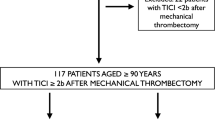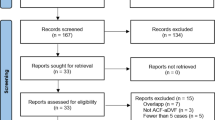Abstract
Introduction
The impact of targeted embolization of ruptured cerebral arteriovenous malformation (AVM)-associated arterial aneurysms in the acute phase of bleeding is not well known. The objective of our study was to analyze the safety and efficacy of this treatment strategy with special emphasis on its protective effect against rebleeding.
Methods
From a prospective database, all patients presenting between December 2005 and March 2012 with a ruptured cerebral AVM associated with arterial aneurysms contiguous to the hemorrhage were selected. Hemorrhagic stroke severity and clinical outcome were measured using, respectively, Glasgow Coma Scale (GCS) and modified Rankin Scale (mRS) scores.
Results
Twenty-five patients with ruptured cerebral AVMs associated with 31 arterial aneurysms contiguous with the hemorrhage were included. In the first group of 17 patients, the mean time to treatment was 30.1 h, while in the second group with 1 patient in poor initial clinical conditions and 7 admitted 7 to 28 days after bleeding, it was 17 days. All arterial aneurysms were totally occluded. Four patients presented rebleeding before treatment (mean interval 9.6 days) and four had rebleeding after treatment (mean interval 8.25 months). At a mean follow-up of 56 months, 21 patients were alive (19 mRS ≤ 2, 2 mRS > 2). Three patients died 2 days, 9 days, and 2 months after bleeding and another died of rebleeding of her residual AVM 19 months after treatment. Treatment-related morbidity and mortality were, respectively, 4 and 0 %.
Conclusion
Selective embolization of arterial aneurysms associated with ruptured AVMs is a safe procedure and could lower the immediate risk of rebleeding.


Similar content being viewed by others
References
Ondra SL, Troupp H, George ED et al (1990) The natural history of symptomatic arteriovenous malformations of the brain: a 24-year follow-up assessment. J Neurosurg 73:387–391
ApSimon HT, Reef H, Phadke RV et al (2002) A population-based study of brain arteriovenous malformation: long-term treatment outcomes. Stroke 33:2794–2800
Halim AX, Johnston SC, Singh V et al (2004) Longitudinal risk of intracranial hemorrhage in patients with arteriovenous malformation of the brain within a defined population. Stroke 2004(35):1697–1702
Mast H, Young WL, Koennecke HC et al (1997) Risk of spontaneous haemorrhage after diagnosis of cerebral arteriovenous malformation. Lancet 350:1065–1068
Meisel HJ, Mansmann U, Alvarez H et al (2000) Cerebral arteriovenous malformations and associated aneurysms: analysis of 305 cases from a series of 662 patients. Neurosurgery 46:793–800
Stapf C, Mohr JP, Pile-Spellman J et al (2002) Concurrent arterial aneurysms in brain arteriovenous malformations with haemorrhagic presentation. J Neurol Neurosurg Psychiatry 73:294–298
Choi JH, Mast H, Sciacca RR et al (2006) Clinical outcome after first and recurrent hemorrhage in patients with untreated brain arteriovenous malformation. Stroke 37:1243–1247
Yamada S, Takagi Y, Nozaki K et al (2007) Risk factors for subsequent hemorrhage in patients with cerebral arteriovenous malformations. J Neurosurg 107:965–972
da Costa L, Wallace MC, Ter Brugge KG et al (2009) The natural history and predictive features of hemorrhage from brain arteriovenous malformations. Stroke 40:100–105
Yu JL, Yang S, Luo Q et al (2011) Endovascular treatment of intracranial ruptured aneurysms associated with arteriovenous malformations: a clinical analysis of 14 hemorrhagic cases. Interv Neuroradiol 17:78–86
Mjoli N, Le Feuvre D, Taylor A (2011) Bleeding source identification and treatment in brain arteriovenous malformations. Interv Neuroradiol 17:323–330
van Rooij WJ, Jacobs S, Sluzewski M et al (2012) Endovascular treatment of ruptured brain AVMs in the acute phase of hemorrhage. AJNR Am J Neuroradiol 3:1162–1166
Gross BA, Du R (2013) Natural history of cerebral arteriovenous malformations: a meta-analysis. J Neurosurg 118:437–443
Krings T, Hans FS, Geibprasert S et al (2010) Partial “targeted” embolisation of brain arteriovenous malformations. Eur Radiol 20:2723–2731
Kano H, Kondziolka D, Flickinger JC et al (2012) Aneurysms increase the risk of rebleeding after stereotactic radiosurgery for hemorrhagic arteriovenous malformations. Stroke 43:2586–2591
Pritz MB (1994) Ruptured supratentorial arteriovenous malformations associated with venous aneurysms. Acta Neurochir 128:150–162
Rahme R, Farley CW, Zuccarello M et al (2011) Transarterial embolization of cerebral arteriovenous malformations: a durable treatment for venous side hemorrhage? Med Hypotheses 76:827–830
Redekop G, TerBrugge KG, Montanera W et al (1998) Arterial aneurysms associated with cerebral arteriovenous malformations: classification, incidence, and risk of hemorrhage. J Neurosurg 89:539–546
Stefani MA, Porter PJ, TerBrugge KG et al (2002) Angioarchitectural factors present in brain arteriovenous malformations associated with hemorrhagic presentation. Stroke 33:920–924
Geibprasert S, Pongpech S, Jiarakongmun P et al (2010) Radiologic assessment of brain arteriovenous malformations: what clinicians need to know. Radiographics 30:483–501
Spetzler RF, Martin NA (1986) A proposed grading system for arteriovenous malformations. J Neurosurg 65:476–483
Fults D, Kelly DL Jr (1984) Natural history of arteriovenous malformations of the brain: a clinical study. Neurosurgery 15:658–662
Crawford P, West CR, Chadwick DW et al (1986) Arteriovenous malformations of the brain: natural history in unoperated patients. J Neurol Neurosurg Psychiatry 49:1–10
Hartmann A, Mast H, Mohr JP et al (1998) Morbidity of intracranial haemorrhage in patients with cerebral arteriovenous malformation. Stroke 9:931–934
Acar F, Men S, Tayfur V, Yilmaz O et al (2006) In vivo intraaneurysmal pressure measurements in experimental lateral wall aneurysms before and after onyx embolization. Surg Neurol 6:252–256
Kano H, Kondziolka D, Flickinger JC et al (2012) Stereotactic radiosurgery for arteriovenous malformations, Part 4: management of basal ganglia and thalamus arteriovenous malformations. J Neurosurg 116:33–43
Kano H, Kondziolka D, Flickinger JC et al (2012) Stereotactic radiosurgery for arteriovenous malformations, Part 5: management of brainstem arteriovenous malformations. J Neurosurg 116:44–53
Chen Y, Zhu W, Bollen AW et al (2008) Evidence of inflammatory cell involvement in brain arteriovenous malformations. Neurosurgery 62:1340–1349
Ethical standards and patient consent
We declare that all human and animal studies have been approved by the ethics committee of the Hospices Civils de Lyon and have therefore been performed in accordance with the ethical standards laid down in the 1964 Declaration of Helsinki and its later amendments. We declare that all patients or their legal representatives gave informed consent prior to inclusion in this study.
Conflict of interest
We declare that we have no conflict of interest.
Author information
Authors and Affiliations
Corresponding author
Rights and permissions
About this article
Cite this article
Signorelli, F., Gory, B., Pelissou-Guyotat, I. et al. Ruptured brain arteriovenous malformations associated with aneurysms: safety and efficacy of selective embolization in the acute phase of hemorrhage. Neuroradiology 56, 763–769 (2014). https://doi.org/10.1007/s00234-014-1395-2
Received:
Accepted:
Published:
Issue Date:
DOI: https://doi.org/10.1007/s00234-014-1395-2




